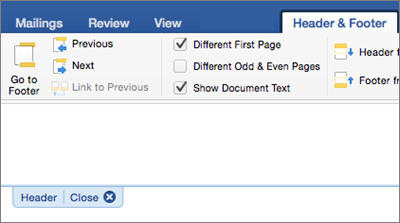Customize the document headers and footers in Word 2011 for Mac to show page numbers, dates, and logos for formal stationery. You can work with headers and footers in several of Word 2011’s views. The quick way to work with headers and footers is by way of the Header and Footer group on the Office 2011 Ribbon’s Document Elements tab.
Clicking either the Header or Footer button displays a gallery from which you can choose a style for your header or footer. The basic layout of three positions (left, center, and right) is the first style on the palette. Notice that some styles affect only odd-numbered or even-numbered pages. Some of the styles apply tables to the header or footer, so if you click into one of these styles, the Format Tables tab on the Ribbon will activate.
Windows macOS - Newer versions Office for Mac 2011 Web Go to Insert Header or Footer, and then select Remove Header or Remove Footer. If your document has more than one section, repeat this process for each section. Windows macOS - newer versions Office for Mac 2011 Go to Insert Header or Footer. Choose the header style you want to use. Tip: Some built-in header and footer designs include page numbers.

Jul 27, 2011 Place your cursor at the point in the text where you want to start the second page. In the main menu bar, choose Insert Break Section Break (Next Page). Select View Header and Footer. In the Ribbon, click on the new purple tab Header and Footer. Oct 29, 2012 A brief lesson on how to perform the necessary tasks in Microsoft Word 2011 (Mac OS X) in order to achieve simple MLA formatting for academic essays. Jul 27, 2011 Place your cursor at the point in the text where you want to start the second page. In the main menu bar, choose Insert Break Section Break (Next Page). Select View Header and Footer. In the Ribbon, click on the new purple tab Header and Footer. Oct 04, 2010 Here is a brief tutorial on inserting Headers and Footers on Microsoft Word for Mac as part of a project by a Technology in Teaching and Learning class from Elon University. For more information. May 14, 2013 The terms Header and Footer arrived from the word processing programs. These denote repeated elements that show at the top and bottom of every page. Headers and Footers are different from each other on PowerPoint slides only considering their position, the Footer is a line of text that usually appears at the bottom of a slide, as shown highlighted in red within Figure 1 below.
When you choose a header or footer style, Word changes the interface so that you can type in your header or footer. You can display this view by choosing View→Header and Footerwithout having to choose a style from the Ribbon. To work with the interface, simply click into it and type. Click the Page # button on the Ribbon to display the Page Numbers dialog, which you can use to choose alignment and formatting options for your page numbers.
To exit Header and Footer view, choose a view from the views listed in the topmost group of the View menu, or double-click the document body. You can also click the small Close button below the Header or above the Footer area.
Download Headers For Microsoft Word

You may want to format your Header or Footer to display Page # of #. To make this custom format starting without a Header or Footer style, do the following:
Header Microsoft Word Mac 2011 Accept Changes
Choose View→Header and Footer from the menu bar.
Click within either the Header or Footer area.
Your cursor will be at the left. Press Tab once or twice to move to the center or right, if desired.
Type the word “Page,” followed by a space.
Choose Insert→Field from the menu bar.
 It is full Latest Version setup of Microsoft Word 2016 15.39 Premium Pro DMG for Apple Macbook OS X.Brief Overview of Microsoft Word 2016 for Mac OS XMicrosoft Word 2016 is a world renowned and most widely used word processing application included in the Office suite.
It is full Latest Version setup of Microsoft Word 2016 15.39 Premium Pro DMG for Apple Macbook OS X.Brief Overview of Microsoft Word 2016 for Mac OS XMicrosoft Word 2016 is a world renowned and most widely used word processing application included in the Office suite.Make sure that Categories is set to (All). Under Field names, choose Page and then click OK.
Add a space and then type of followed by another space.
Choose Insert→Field from the menu bar.
Under Field Names, choose NumPages and then click OK.